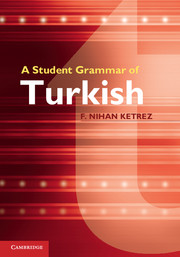Book contents
- Frontmatter
- Contents
- Acknowledgments
- Conventions used in the book
- Chapter 1 Introduction
- Chapter 2 The sounds of Turkish
- Chapter 3 The noun: an overview
- Chapter 4 Case markers
- Chapter 5 Genitive and possessive
- Chapter 6 Numerals and plurality
- Chapter 7 Existential var / yok
- Chapter 8 Pronouns
- Chapter 9 The verb: an overview
- Chapter 10 -Iyor, the progressive
- Chapter 11 Future with -(y)AcAK
- Chapter 12 Past with -DI and -(y)DI
- Chapter 13 -mIş and -(y)mIş
- Chapter 14 Present tense with the aorist -Ir/-Ar
- Chapter 15 -mAktA and -DIr
- Chapter 16 Imperative and optative
- Chapter 17 Compound tenses
- Chapter 18 Person markers
- Chapter 19 Postpositions
- Chapter 20 Passive
- Chapter 21 Causative
- Chapter 22 Reflexive
- Chapter 23 Reciprocal
- Chapter 24 Subordination
- Chapter 25 Infinitives with -mA and -mAK
- Chapter 26 Adjectives
- Chapter 27 Adverbials
- Chapter 28 Conditional
- Chapter 29 Ability and possibility with -(y)Abil
- Chapter 30 Obligation and necessity
- Chapter 31 Relative clauses
- Chapter 32 Word order
- Chapter 33 Questions
- Chapter 34 Negation
- Chapter 35 Coordination
- Chapter 36 Diminutive
- Chapter 37 Reduplication
- Chapter 38 Interjections and some idiomatic expressions
- Chapter 39 Spelling and punctuation
- Chapter 40 Conversation
- Appendix A Verbal inflection paradigms
- Appendix B Nominal inflection paradigms
- Appendix C Verbs categorized according to their case-marked complements
- Appendix D Verbs categorized according to their clausal complement types
- Appendix E Selected grammar books for further study
- Appendix F Answer key to the exercises
- Appendix G Glossary of grammatical terms
- Index
Chapter 1 - Introduction
Published online by Cambridge University Press: 05 June 2012
- Frontmatter
- Contents
- Acknowledgments
- Conventions used in the book
- Chapter 1 Introduction
- Chapter 2 The sounds of Turkish
- Chapter 3 The noun: an overview
- Chapter 4 Case markers
- Chapter 5 Genitive and possessive
- Chapter 6 Numerals and plurality
- Chapter 7 Existential var / yok
- Chapter 8 Pronouns
- Chapter 9 The verb: an overview
- Chapter 10 -Iyor, the progressive
- Chapter 11 Future with -(y)AcAK
- Chapter 12 Past with -DI and -(y)DI
- Chapter 13 -mIş and -(y)mIş
- Chapter 14 Present tense with the aorist -Ir/-Ar
- Chapter 15 -mAktA and -DIr
- Chapter 16 Imperative and optative
- Chapter 17 Compound tenses
- Chapter 18 Person markers
- Chapter 19 Postpositions
- Chapter 20 Passive
- Chapter 21 Causative
- Chapter 22 Reflexive
- Chapter 23 Reciprocal
- Chapter 24 Subordination
- Chapter 25 Infinitives with -mA and -mAK
- Chapter 26 Adjectives
- Chapter 27 Adverbials
- Chapter 28 Conditional
- Chapter 29 Ability and possibility with -(y)Abil
- Chapter 30 Obligation and necessity
- Chapter 31 Relative clauses
- Chapter 32 Word order
- Chapter 33 Questions
- Chapter 34 Negation
- Chapter 35 Coordination
- Chapter 36 Diminutive
- Chapter 37 Reduplication
- Chapter 38 Interjections and some idiomatic expressions
- Chapter 39 Spelling and punctuation
- Chapter 40 Conversation
- Appendix A Verbal inflection paradigms
- Appendix B Nominal inflection paradigms
- Appendix C Verbs categorized according to their case-marked complements
- Appendix D Verbs categorized according to their clausal complement types
- Appendix E Selected grammar books for further study
- Appendix F Answer key to the exercises
- Appendix G Glossary of grammatical terms
- Index
Summary
Turkish is a member of the Southwestern branch (Oghuz) of the Turkic language family. It is the most commonly spoken Turkic language, acquired as a native language by more than 77 million people worldwide. The variety of Turkish presented in this book is the standard variety of the modern Turkish spoken in Turkey today. Here are some quick facts about the modern Turkish language:
Turkish is an agglutinating language. In Turkish, you add a number of suffixes to a word to make a sentence. Gidiyorum is one single word in Turkish, which means ‘I am going.’ It is made up of the verb git ‘go’ and two suffixes iyor (the progressive marker) and um (first person ‘I’). Kitaplarınızdan means ‘from your books’: kitap + lar + ınız + dan (book + s + your + from). This is called agglutination, a term which means ‘glue together’ in Latin. Due to the agglutinating nature of the language, it is possible to form very long words. A very well-known example is
Avrupalılaştıramadıklarımızdan mısınız
‘Are you one of those whom we cannot make European’?
However, in everyday speech, you almost never hear such super-long words. On average, a speaker adds about two or three suffixes to a verbal or nominal stem.
- Type
- Chapter
- Information
- A Student Grammar of Turkish , pp. 1 - 3Publisher: Cambridge University PressPrint publication year: 2012



